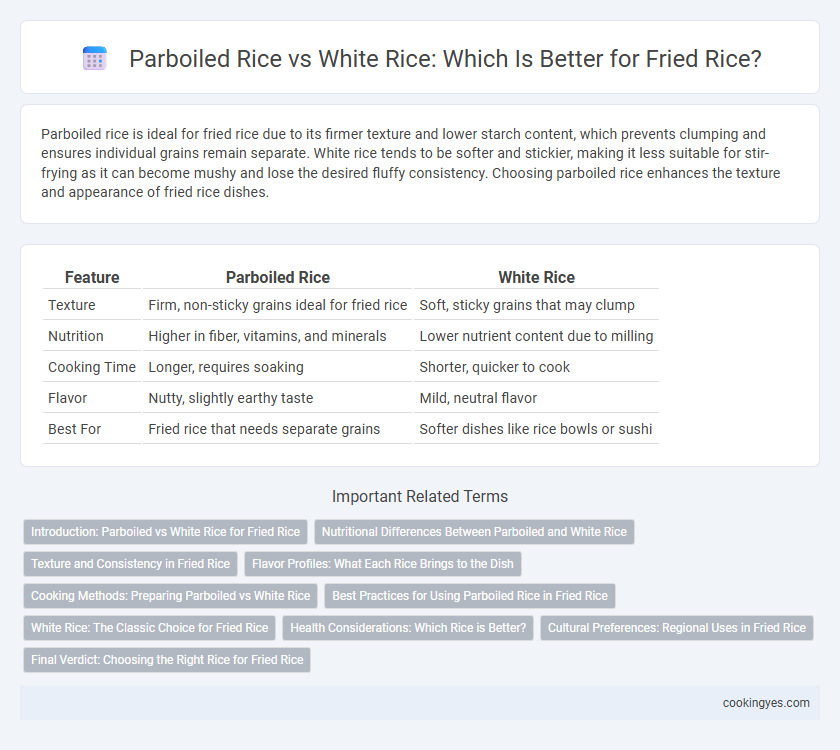Parboiled rice is ideal for fried rice due to its firmer texture and lower starch content, which prevents clumping and ensures individual grains remain separate. White rice tends to be softer and stickier, making it less suitable for stir-frying as it can become mushy and lose the desired fluffy consistency. Choosing parboiled rice enhances the texture and appearance of fried rice dishes.
Table of Comparison
| Feature | Parboiled Rice | White Rice |
|---|---|---|
| Texture | Firm, non-sticky grains ideal for fried rice | Soft, sticky grains that may clump |
| Nutrition | Higher in fiber, vitamins, and minerals | Lower nutrient content due to milling |
| Cooking Time | Longer, requires soaking | Shorter, quicker to cook |
| Flavor | Nutty, slightly earthy taste | Mild, neutral flavor |
| Best For | Fried rice that needs separate grains | Softer dishes like rice bowls or sushi |
Introduction: Parboiled vs White Rice for Fried Rice
Parboiled rice retains more nutrients and has a firmer texture, making it ideal for fried rice dishes that require separate, non-sticky grains. White rice, often softer and more delicate, tends to clump, resulting in a different texture and flavor profile in fried rice. Choosing parboiled rice enhances dish consistency and improves the overall mouthfeel, especially in stir-fried recipes.
Nutritional Differences Between Parboiled and White Rice
Parboiled rice retains more nutrients such as vitamins B1, B3, and minerals like magnesium and zinc due to its unique steaming process before husking, making it a healthier choice compared to white rice. White rice undergoes polishing that removes the bran and germ layers, resulting in lower fiber content and reduced levels of essential nutrients. For fried rice dishes, using parboiled rice enhances nutritional value while maintaining a firm texture that resists becoming mushy during cooking.
Texture and Consistency in Fried Rice
Parboiled rice offers a firmer texture and distinct grain separation, ideal for fried rice as it prevents clumping and maintains a chewy consistency. White rice, especially jasmine or long-grain varieties, delivers a softer, fluffier texture but tends to stick together, which can lead to a mushier fried rice. The choice between parboiled and white rice significantly impacts the final dish's mouthfeel and visual appeal.
Flavor Profiles: What Each Rice Brings to the Dish
Parboiled rice offers a nutty, slightly earthy flavor that holds up well in fried rice, providing a firmer texture and individual grain separation, ideal for absorbing sauces and seasonings. White rice delivers a milder, more neutral taste that allows other ingredients to shine, with a softer, stickier consistency that creates a cohesive bite. Both types contribute unique flavor profiles, influencing the overall taste and texture experience in fried rice dishes.
Cooking Methods: Preparing Parboiled vs White Rice
Parboiled rice involves soaking, steaming, and drying the grain before milling, which partially gelatinizes the starch and makes it firmer and less sticky when cooked, ideal for fried rice that requires separate grains. White rice undergoes full milling and polishing, resulting in softer, stickier grains that may clump during frying without proper cooking techniques. Properly rinsing and slightly undercooking white rice before frying prevents mushiness, while parboiled rice can be cooked fully and cooled without losing its firm texture, enhancing the final fried rice's consistency.
Best Practices for Using Parboiled Rice in Fried Rice
Parboiled rice is ideal for fried rice due to its firm texture and reduced stickiness, which prevents clumping during cooking. Best practices include rinsing the rice thoroughly before cooking and using day-old parboiled rice to achieve optimal separation of grains. Cooking the rice with slightly less water than usual helps maintain its structural integrity, resulting in a fluffy and non-greasy fried rice dish.
White Rice: The Classic Choice for Fried Rice
White rice is the classic choice for fried rice due to its neutral flavor and fluffy texture, which absorbs sauces and spices effectively. Its low moisture content prevents clumping, ensuring each grain remains separate and ideal for stir-frying. Compared to parboiled rice, white rice offers a softer bite that complements traditional Asian fried rice dishes.
Health Considerations: Which Rice is Better?
Parboiled rice retains more nutrients such as vitamin B6, iron, and fiber due to its steaming process, making it a healthier option for fried rice compared to white rice, which loses many nutrients during polishing. The lower glycemic index of parboiled rice contributes to better blood sugar control, beneficial for people with diabetes or weight management goals. Choosing parboiled rice for fried rice supports improved digestion and sustained energy release, enhancing overall health benefits.
Cultural Preferences: Regional Uses in Fried Rice
Parboiled rice is favored in South Asian and Caribbean fried rice recipes for its firmer texture and ability to remain separate when stir-fried, enhancing the dish's overall consistency. White rice is more commonly used in East Asian cuisines, such as Chinese and Japanese fried rice, where a softer, stickier grain complements the other ingredients. Regional preferences highlight how parboiled rice supports longer cooking times without becoming mushy, while white rice's delicate texture suits quicker stir-frying techniques popular in many Asian cultures.
Final Verdict: Choosing the Right Rice for Fried Rice
Parboiled rice offers firmer, less sticky grains that hold up well during frying, creating distinct texture and flavor ideal for fried rice. White rice, particularly medium or long grain, provides softer, stickier grains that absorb sauces more readily but can clump if overcooked. For the best fried rice, parboiled rice ensures separate, fluffy grains, making it the preferred choice for achieving authentic texture and taste.
Parboiled vs White for fried rice Infographic

 cookingyes.com
cookingyes.com